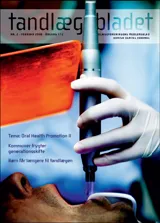Karies i Norge fortid og fremtid: Analyse av endringer og årsaker
Artikkelen gir en oversikt over kariesutviklingen blant barn og ungdom i Norge i historisk perspektiv for (i) å vurdere mulige årsaker til endringer i kariesprevalens og erfaring og for (ii) å fremskrive tannstatus for voksenbefolkningen på grunnlag av kariessituasjonen i dag. Rapporter fra offentlig tannpleie viser at andelen kariesfrie 5-åringer økte fra 1985 til 1997, sank så med 9-10 prosentpoeng fra 1997-2001 for deretter å stige til 1997-nivå (ca. 70 %) i 2005. I det permanente tannsettet var karieserfaringen blant barn høy allerede i 1897, den sank under 2. verdenskrig, økte deretter til midt på 1960-tallet for så å synke frem til årtusenskiftet. Etter år 2000 har D3MFT-tallene for 12- og 18-åringer vært relativt stabile, men andelen kariesfrie (D3-nivå) har vist stigende tendens. Bedringen i tannhelsen under 2. verdenskrig tilskrives i hovedsak redusert sukkerkonsum. Bedre tannhelse etter 1965 skyldes deltagelse i skolebaserte fluorprogrammer, bruk av fluortannkrem (fra 1971), fluortabletter, fluorpensling og, etter 1980, også endrede indikasjoner for fyllingsterapi. Om status presens legges til grunn, vil antallet egne tenner hos voksne øke raskt frem til 2020 og antallet kariesaffiserte tenner (DMFT) kan komme til å synke til ca. 10 ved fylte 70 år i 2055.
Caries trend in Norway and possible reasons for observed changes: A review of the trend in caries prevalence and experience among Norwegian children and adolescents is presented in order to (i) assess possible reasons for the observed changes and (ii) attempt to predict the future dental status of adults based on the trends seen in recent years. According to available evidence, the proportion of caries-free 5-year-old children increased from 50 % in 1985 to nearly 70 % in 1997, then fell by 10 percentage points during the next four years, reaching 70 % again in 2005. Caries experience in the permanent dentition of Norwegian children was high as far back as 1897; it then fell during the Second World War, increased again until the mid-1960s and declined until the year 2000. Since 2000, the number of D 3 MFT among 12- and 18-year-olds has remained fairly stable. The observed fall in caries experience during the Second World War can be attributed mainly to a dramatic reduction in sugar consumption. The caries decline after 1965 is ascribable to several factors, e. g. children’s participation in supervised fluoride mouth rinsing or brushing programmes at school, use of fluoride-containing toothpaste (from 1971) and fluoride tablets, professional topical application of fluoride agents and after 1980, the change in the indications for restorative treatment. Prediction of the future dental status of adults based on recent developments indicates that in the coming 15 years, tooth loss and edentulousness will decrease rapidly and that in 2055 the number of D 3 MFT may fall to about 10 among 70-year-olds.


